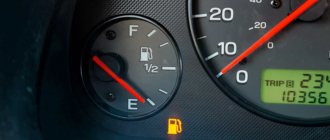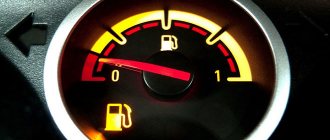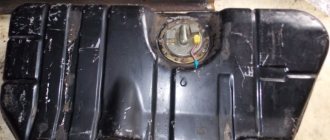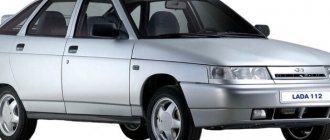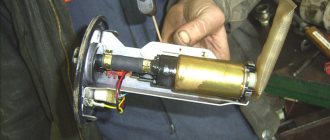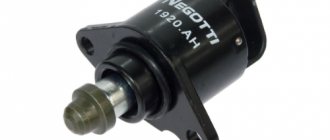The design of each car provides a special container - a fuel tank. Among its tasks is not only to provide the car with enough diesel fuel or gasoline for a long trip, but also to prevent fuel leaks and emissions of harmful substances. The tanks must be completely sealed, but depending on the car model they may differ in shape, material and volume. Moreover, the last characteristic is one of the main ones; you need to know it both to determine the cost of refueling and to plan a trip.
Types of fuel tanks and materials of manufacture
There is no single form and design of fuel storage tanks. To obtain the maximum volume of fuel tanks, their geometry is made complex - and different not only for individual brands, but also for each model. The containers differ in both material and equipment.
Main components of the gas tank
The list of equipment items differs for different vehicles. But most of them are universal and the same for all cars:
- Housing – steel, plastic or aluminum.
- The neck through which fuel is poured.
- A neck cover that may have a lock.
- An intake pipe, instead of which there may be a pump for pumping fuel.
- Sensor for monitoring fuel level.
- Tube and valve included in the ventilation system.
- Drain hole or pipe.
The standard set of equipment can be supplemented with other devices. Each model has its own list, which is described in the technical documentation for the vehicle. It is advisable for all car owners to study it in order to avoid mistakes when operating the car.
Design and principle of operation of the ventilation system
When considering the features of tanks of different cars, it is worth paying attention to the ventilation system, which solves several important problems:
- remove excess air from the tank during refueling;
- maintain the pressure at atmospheric pressure and avoid vacuum that could lead to tank deformation;
- maintain a safe temperature inside.
Most modern cars have a closed fuel tank ventilation system. The tanks do not have direct access to the atmosphere - a whole set of special devices are used to let air in. As the vacuum increases, the valve spring is pressed out. Air begins to enter inside until a pressure equal to atmospheric pressure is established inside.
Features of the design of fuel tanks in modern cars
Designers who design fuel tanks consider sealing first. No oil products should leak from the container and no evaporation should escape. Another important point is corrosion protection. You can avoid rust by using the following materials:
- high-quality steel, which is more often used on trucks;
- light alloys or aluminum, which can be found on passenger cars;
- polymers, thanks to which tanks of complex design are obtained.
Plastic tanks are considered the most convenient due to the complete absence of corrosion and lower weight. The disadvantage of plastic is its high permeability to gasoline and the likelihood of leaks. It can be compensated by using 2 layers of polymer.
Repair features
During long and active use, the tank may become damaged. There is no need to immediately panic or buy another one - sometimes you can get by with repairs.
Damaged plastic containers must be sealed. Repairs using sealant or glue are contraindicated. There are two types of repair of plastic products: welding using a hot air gun and the extrusion method.
A more effective option is the extrusion type of repair. It requires specialized equipment, but the results will be worth it.
Welding with a hot air gun occurs using a special additive. This is not as effective a method as the previous one. The damage site after repair will not be as strong as after extrusion repair. But this method benefits from its low price.
Metal containers are repaired using welding. Repair is necessary if a leak occurs and a leak occurs. If this is a fuel tank or a container that contained petroleum products, it is necessary to observe safety precautions, because negligence can lead to an explosion. In such cases, before repair work, a long procedure of cleaning the tank and steaming, followed by evaporation, is carried out.
The second type of repair of metal products is cold welding. This type of repair is simple and accessible to everyone, but it is only a temporary measure. To carry out repairs yourself, you need to buy a sealing compound. The first step is to clean and degrease the damaged area. Then we take the required amount of sealing compound and knead it. We apply “cold welding” to the damage and cover it up.
The third repair option involves the use of epoxy resin and fiberglass patches. The repair takes place as follows: epoxy resin is applied to the defect, a patch is applied on top, and so on in several layers. The drying process lasts about a day, after which the former damage site is polished with sandpaper. This method is suitable for eliminating very minor damage.
It is better not to spare money on repairing metal containers; most likely, after repair they will last for many more years. If the plastic product is severely damaged, you should think about it, perhaps it would be more advisable to buy a new one.
Why are the numbers in your passport not accurate?
The actual tank capacity is usually greater than the data in the car documents. Therefore, if the vehicle’s passport indicates 60-65 liters, the actual volume is 70-75 liters. Most car manufacturers add about 10-15%.
One of the reasons for the differences due to which the figures in the passport are inaccurate is the need for a reserve to compensate for the expansion of the fuel as the temperature changes. The pressure inside the container does not increase, and fuel does not leak out. The second reason is protection against fuel leaks when the car, and therefore the tank, is tilted.
What are the tank sizes?
The average gas tank volume corresponds to the type of car:
- for small cars the value is in the range of 30-40 liters;
- for medium passenger cars – 50-80 l;
- for small trucks - 90-160 l;
- for trucks like KAMAZ - about 350 liters.
Based on the working volume of the fuel storage tank, you can find out how far the car can travel after full refueling. Although for this you will also need to know the engine parameters and take into account the driving mode - city, highway, combined.
“Advantages” of installing a VZU in the gas tank flap
Convenient installation and location. Installing the VDU near the gas tank filler neck involves drilling a hole in the car body, after which the installation location will be hidden from prying eyes under the gas tank flap cover. This arrangement is convenient in that the two filling holes will be in the same place, which simplifies refueling and eliminates the possibility of dirt and dust getting into the VZU. Aesthetic appearance
Since the VZU will be hidden under the cover, nothing will spoil the appearance of your car, and this is very important for most motorists. Dust, moisture and dirt protection. Unlike the VZU in the bumper, its location near the filler neck eliminates troubles such as the ingress of dirt or moisture, as well as the likelihood of icing in winter
Regardless of weather conditions, the remote refueling device of your car will always be clean and will not cause you problems with refueling. In case of unsuccessful parking or a hit in the rear, you will not have to worry about the VZU. Damage to the bumper is a fairly common “sore”, so installing a remote refueling device in the gas tank flap allows you to avoid possible troubles that arise after damage to the refueling device from an impact. Anti-vandal protection of VZU. The location of a remote refueling device under the gas tank flap will save you from possible problems with vandals that may arise if the fuel filler is installed in the bumper. The refueling device will be securely hidden under the hatch cover and will not attract unnecessary attention to anyone.
Fuel tanks of passenger cars
Passenger vehicles have an average tank capacity of about 50 liters. Although, for example, three similar cars, Lada Vesta, Kia Rio and Hyundai Solaris, received tanks of different capacities. The domestic model has 55 liters of fuel in the tank, and 43 liters for both foreign cars.
A larger car, which also belongs to a passenger car, can be equipped with a tank with a capacity of 64 liters. And the Toyota Land Cruiser SUV, which can consume both 15 and 20 liters of gasoline - even with a 93-liter tank.
Fuel tank cap design
The design of the cap depends on the design of the fuel tank neck, the structure of the fuel tank itself and the design of the entire fuel system. The most noticeable parameters are the diameter of the thread and its type (internal, external), volume, and depth of entry into the neck. The material from which the gas tank cap is made is assessed in terms of fire safety requirements, as well as the ability to withstand the influence of aggressive fumes.
Owners of some Citroen cars are forced to carry the fuel tank cap around the gas station, as it has a lock that does not allow the key to be removed from the cylinder.
Structurally, covers can be divided into several main types. The first and simplest has only one function - the cap must isolate the fuel from the external environment and from car parts. Covers of more complex designs are equipped with valves that ensure stable pressure in the tank. Some lids have a lock. There are also covers with a device “for the forgetful” - attached with a flexible connection either to the neck of the tank or to the hatch cover.
Truck tank capacities
Determining how many liters of fuel fits in a truck's tank is more difficult. There are not even approximate standards for such cars. For example, for different modifications of a KAMAZ vehicle, the volume is in the range of 175-500 liters. The average value is 350 l. But there are modifications with 600-liter tanks.
Large trucks like SCANIA 113 also have spacious tanks - 300-500 liters. The DAF XF truck is equipped with an 870 liter tank. And the MAN F90 with a load capacity of up to 48 tons has a tank capacity of up to 1260 liters.
Dimensions
What is necessary for high-quality installation of a tank on KamAZ? Full compliance with dimensions. Before you purchase it, you need to make sure it is fully compatible with a specific KamAZ truck model. One of the most important indicators of dimensions is the length of the tank. The KamAZ plant and its subsidiaries adhere to the following values for this parameter (in mm):
- 710;
- 750;
- 950;
- 1200;
- 1360;
As for the cross-sectional dimensions, they range from 400×490 to 660×660 mm. But, again, these indicators are characteristic of the main manufacturer, while others may have almost any modification. To date, the maximum length does not exceed 1920 mm.
How to determine the real volume yourself
You need to know the approximate (with an accuracy of about a liter) volume of the fuel tank so as not to encounter underfilling at a gas station. Or that when refueling, the meter will show a larger number than what actually fits in a tank of that size. There are many ways to determine capacity - from the use of traditional methods to calculations.
Folk tricks
There are no instruments to measure such an indicator. But on automotive forums you can find advice on determining volumes. Among them is rocking the car to evaluate the sound from the splash and even weighing the car and comparing it with the passport data.
One of the fairly simple and accurate, but not too fast options is to drain the fuel, measure its volume and fill it back. But there are methods that allow you to determine the volume faster and more accurately. For example, using the dashboard.
By instruments
If the fuel indicator is in good condition, you can do without calculations and navigate only by instruments. For example, if the analog scale is divided into 10 divisions, and the approximate volume of the tank is 50 liters (according to the passport data), then each mark indicates 5 liters of capacity. This can be checked by filling the car with 5 liters and checking the change in the instrument readings. If after refueling the needle has moved not by 1 division, but more or less, the volume is recalculated.
The method will be relatively accurate if the machine is standing on a completely horizontal platform. In addition, it is not always possible to find out the maximum usable volume with its help - the last division of the scale usually coincides with the numbers on the passport.
Using diagnostic mode
Another method is only suitable for cars with a Renault dashboard. It is installed on all cars of this brand and some Nissan models. To start diagnostics, perform the following steps:
- Before starting the engine, hold down the mileage reset button for the last 24 hours for 5 seconds.
- Turn on the ignition and release the button when the instrument arrows continue to move.
- Using the same button, switch the diagnostic mode by selecting the icon with the image of a gas pump.
The method allows you to determine not the volume of the tank, but the amount of remaining gasoline or diesel fuel. The tank capacity will be known when it is full. The initial figure is added to the volume of fuel filled.
With sensor
In the absence of special dashboard modes, the amount of gasoline or diesel fuel can be determined using a sensor. It is installed directly into the tank and connects to the control device wirelessly.
This type of device is battery operated and lasts for at least 5 years. With its help, during the operation of the car, you can find out quite accurately how much fuel is left. And when the tank is full, the volume of the tank with an error is less than 1 liter.
Why do you need a gasoline vapor recovery system?
Environmental protection requires EVAP systems on vehicles because fuel vapors contain various hydrocarbons (HC). The light elements in gasoline evaporate easily, especially in warm weather. These include aldehydes, aromatic compounds, olefins and higher paraffins.
These substances react with air and sunlight (called a photochemical reaction), forming smog. Aldehydes are often called flash smog because they can form smog without undergoing photochemical changes.
The disadvantage of fuel vapor is that the fuel evaporates whenever it is in the tank. This means that if the fuel system is leaking or open to the atmosphere, it can pollute the atmosphere 24 hours a day, even if the car is not driving anywhere.
Fugitive evaporative emissions like this can account for up to 20% of the pollution produced by a car.
The EVAP system completely eliminates fuel vapor as a source of air pollution by isolating the fuel system from the atmosphere. Vent lines from the fuel tank direct vapors to the canister, where they are captured and stored until the engine starts.
When the engine has warmed up and the car is moving on the road, the ECU opens the purge valve, allowing vapors to be pumped out of the canister into the intake manifold. That's it, fuel vapors burn in the engine.

